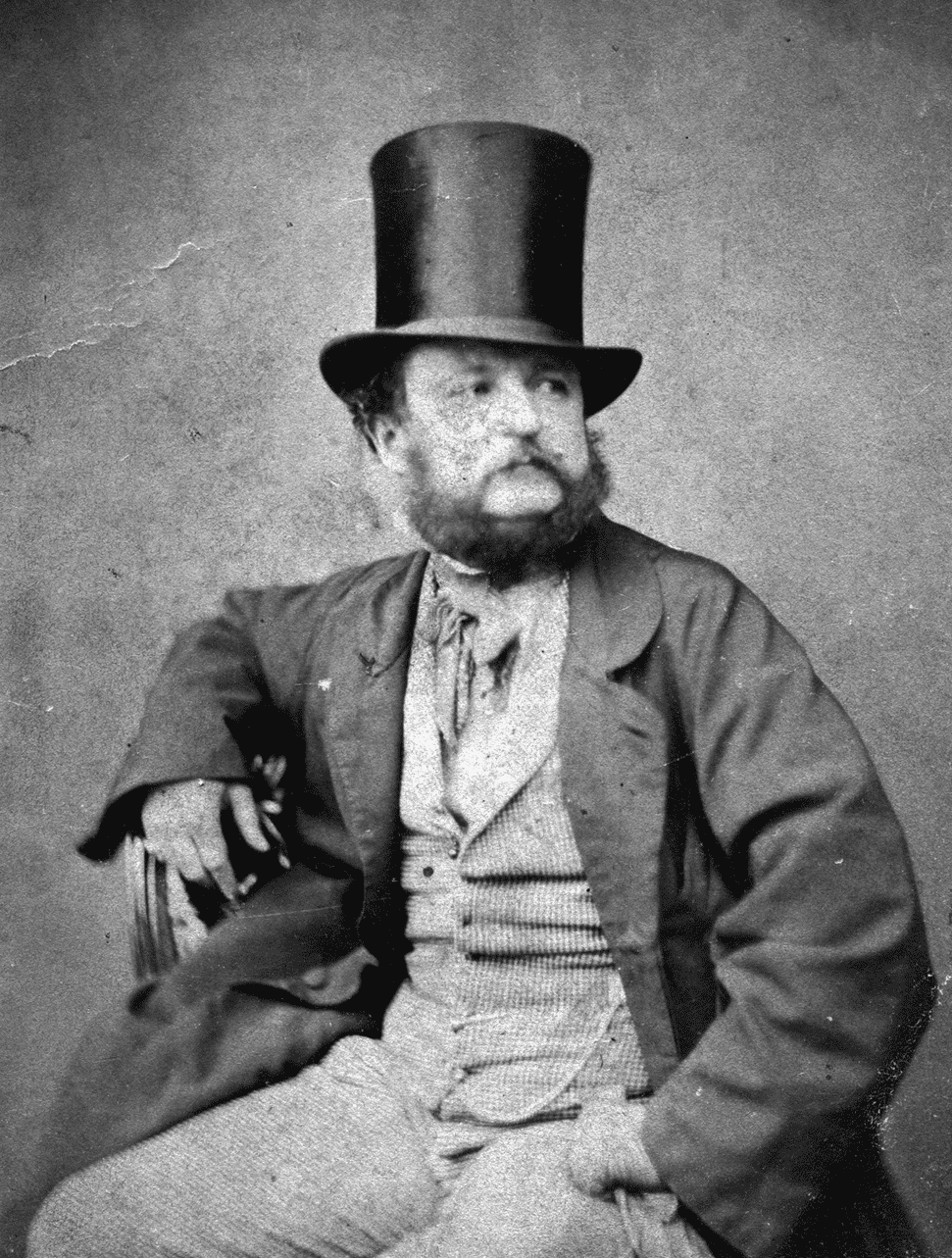



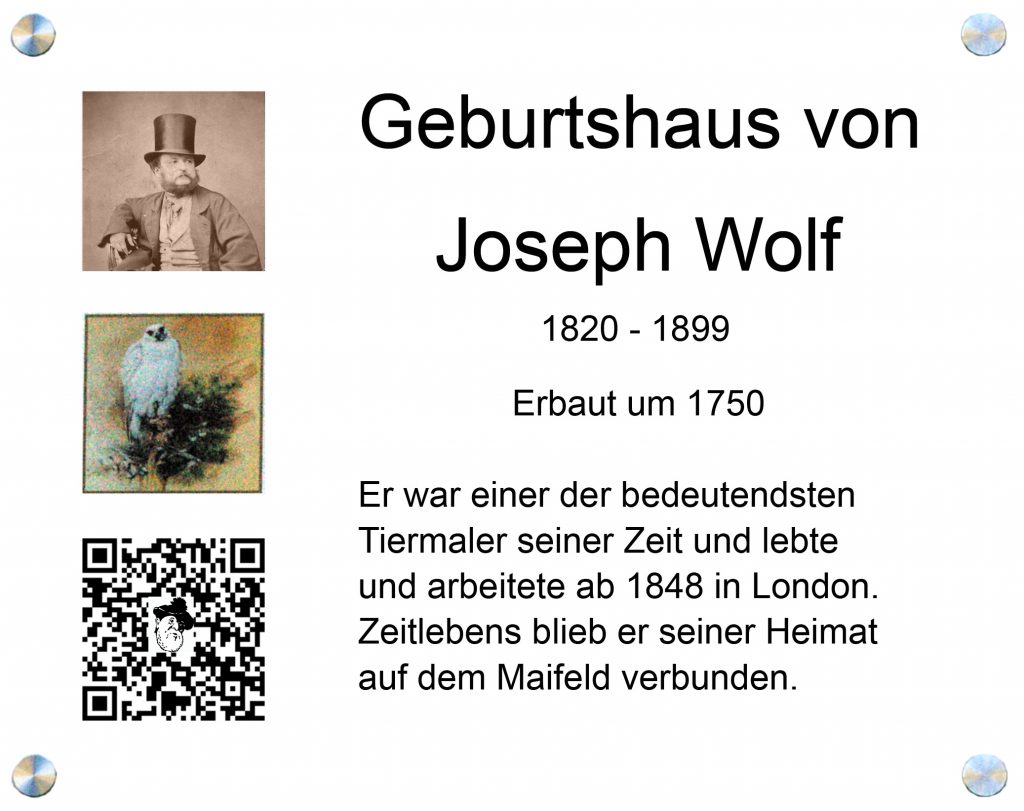
Joseph Wolf wurde am 22. Januar 1820 als Mathias, Sohn von Anton und Elisabeth Wolf (geb. Probstfeld), in Mörz geboren. Er zeigte schon als Kind ein außergewöhnliches Talent als Zeichner und Maler. Seine letzten fünfzig Lebensjahre verbrachte er von der Fachwelt hoch geachtet in London.
Wolf wurde in der Koblenzer Steindruckerei der Gebrüder Becker zum Lithografen ausgebildet und bekam anschließend Kontakt zu Eduard Rüppell (1794–1884) in Frankfurt am Main, der gerade aus Afrika zurückgekommen war und einen Illustrator für sein Werk über die Vögel Nordostafrikas suchte. Rüppell war begeistert von den Fähigkeiten des jungen Mannes und vermittelte ihn an Johann Jakob Kaup (1803–1873), den Direktor des Großherzoglichen Naturalienkabinetts in Darmstadt. Hier besuchte Wolf den Kunstunterricht des Akademiedirektors Carl Ludwig Seeger (1808–1866). Wolf blieb bis 1847 in Darmstadt und war als freischaffender Künstler und Illustrator ornithologischer Fachbücher tätig, seinen Lebensunterhalt verdiente er als Lithograf. Von 1847 bis März 1848 studierte Wolf in Antwerpen an der Königlichen Kunstakademie.
Auf Empfehlung Kaups erhielt Wolf erste Illustrationsaufträge von dem Ornithologen Hermann Schlegel (1804–1884), der als Inspektor am Reichsmuseum für Naturgeschichte im holländischen Leiden tätig war. Nachdem Schlegel Wolfs Skizzenbuch mit Darstellungen von Greifvögeln gesehen hatte, die alle Erwartungen übertrafen, beauftragte er ihn mit der Herstellung der Tafeln seines Traité de Fauconnerie, des größten und schönsten Falkenbuches, das je erschienen ist. Diese 12 Lithographien von 1845 verhalfen Wolf zu einem nachhaltigen Karriereschub, da diese fantastischen lebensgroßen Farbtafeln in Fachkreisen schnell Bewunderung und Erstaunen hervorriefen.
Inzwischen war man auch in London, dem damaligen Zentrum der Naturgeschichte, auf den jungen Wolf aufmerksam geworden. Bereits im Herbst 1847 wurde er von dem Maler David William Mitchell (1794–1859) zur Mitarbeit an George Robert Grays (1808–1872) Genera of Birds nach London eingeladen.
Am 20. März 1848* fuhr Wolf mit der Soho nach England, wo er mit Illustrationsaufträgen praktisch überhäuft wurde. Hier arbeitete er künstlerisch und wirtschaftlich sehr erfolgreich, u.a. als Illustrator für Darwin, Livingstone, und vor allem für die Zoological Society of London. Er revolutionierte die Technik der Tierillustrationen und übte stilistisch großen Einfluss auf die Tiermalerei in England aus.
Auch die zur damaligen Zeit berühmten Tiermaler Landseer und Gould schätzten seine Mitarbeit. Selbst Königin Victoria hat ein Werk Wolfs (ein Aquarell eines Dompfaffs) als Geburtstagsgeschenk erhalten. Er entwickelte sich innerhalb kürzester Zeit zum bedeutendsten Tiermaler seiner Zeit. Es gibt kaum ein Tafelwerk, diesseits oder jenseits des Atlantiks, an dem Wolf nicht beteiligt war.
Neben den wissenschaftlichen Illustrationen schuf Wolf aber auch viele Gemälde, die sich nach wie vor in öffentlichen und privaten Sammlungen befinden und zu Höchstpreisen gehandelt werden. Wegen zunehmender Sehschwäche und quälendem Gelenkrheumatismus musste Joseph Wolf ab etwa 1870 das Lithographieren jüngeren Kollegen überlassen und widmete sich zunehmend der komplexen malerischen Wiedergabe des Überlebenskampfes in der Natur.
Obwohl Joseph Wolf durch seinen langen Aufenthalt in London mehr und mehr zu einem „Engländer“ wurde, pflegte er seine Beziehungen zur alten Heimat und besuchte immer wieder seine alte Heimatgemeinde Mörz.
Anlässlich seines 100. Todestages wurde die längst überfällige Retrospektive vorbereitet, die im Biohistoricum in Neuburg an der Donau am 29. Juni 2000 eröffnet wurde. Dem Lebensweg Wolfs folgend wurde die Ausstellung danach auch im Hessischen Landesmuseum in Darmstadt, im Nationaal Natuurhistorisch Museum in Leiden (heute „Naturalis, Biodiversity Center” genannt) und im Natural History Museum in London gezeigt.
Joseph Wolf starb in seinem Haus, Nr. 2, Primrose Hill Studios am 20. April 1899, umgeben von seinen Ziervögeln. Er wurde auf dem Friedhof Highgate East beerdigt.
Joseph Wolf hatte vier Töchter. Seine erste Tochter, Helen Elizabeth Wolf Cooper (1854-1937), stammt von Mary Ann Cooper (geb. Brewer) (1816-1873), 17 Howland Street London. Helens Nachkommen sind die Familien Todd und Dumeresque.
Mit Kezia Louisa Willingale (1841-1893) hatte Joseph Wolf drei Töchter. Nur eine von ihnen, Celestine Wolf (1865-1941), hatte Kinder. Von ihr stammt die Familie Welland (Neuseeland). Wolfs Nachkommen leben heute in Großbritannien, Südafrika und Neuseeland.
In 2002 wurde eine neue Straße in Mörz nach ihm benannt.
Am 22. Januar 2020 feierte Mörz seinen 200. Geburtstag mit Vorträgen, Musik und Lesungen. (Fotos unten)

Joseph Wolf was born on January 22nd, 1820 as Mathias, the son of Anton and Elisabeth Wolf (née Probstfeld) in Mörz. Already as a child he showed an extraordinary talent as a draftsman and painter. He lived the last fifty years of his life in London, highly respected by the experts.
Wolf trained as a lithographer in the Becker brothers‘ Koblenz lithography studio and then came into contact with Eduard Rüppell (1794-1884) in Frankfurt am Main, who had just returned from Africa and was looking for an illustrator for his work on the birds of northeast Africa. Rüppell was enthusiastic about the young man’s abilities and referred him to Johann Jakob Kaup (1803-1873), the director of the Grand Ducal Natural History Cabinet in Darmstadt. Here Wolf attended the art lessons of the academy director Carl Ludwig Seeger (1808-1866). Wolf remained in Darmstadt until 1847 and worked as a freelance artist and illustrator of ornithological textbooks, earning his living as a lithographer. From 1847 to March 1848 Wolf studied in Antwerp at the Royal Academy of Arts.
On Kaup’s recommendation, Wolf received his first orders for illustrations from the ornithologist Hermann Schlegel (1804-1884), who worked as an inspector at the Reich Museum of Natural History in Leiden, Holland. After Schlegel had seen Wolf’s sketchbook with depictions of birds of prey that exceeded all expectations, he commissioned him to produce the plates for his Traité de Fauconnerie, the largest and most beautiful falconry book ever published. These 12 lithographs from 1845 gave Wolf a lasting boost to his career, as these fantastic life-size color plates quickly aroused admiration and amazement in specialist circles.
In the meantime, the young Wolf had also caught the attention of London, the center of natural history at the time. Already in autumn 1847 he was invited by the painter David William Mitchell (1794-1859) to work with George Robert Gray’s (1808-1872) Genera of Birds in London.
On March 20, 1848*, Wolf sailed with the Soho to England, where he was practically inundated with orders for illustrations. Here he worked very successfully, both artistically and economically, including as an illustrator for Darwin, Livingstone, and especially for the Zoological Society of London. He revolutionized the technique of animal illustration and had a great influence on the style of animal painting in England.
The famous animal painters Landseer and Gould also appreciated his collaboration. Even Queen Victoria received a work by Wolf (a watercolor of a bullfinch) as a birthday present. Within a very short time he became the most important animal painter of his time. There is hardly a panel work, on this side or the other side of the Atlantic, in which Wolf was not involved.
In addition to scientific illustrations, Wolf also created many paintings, which are still in public and private collections and are traded at top prices. Due to increasing shortsightedness and agonizing rheumatoid arthritis, Joseph Wolf had to leave lithography to younger colleagues from around 1870 onwards, and increasingly devoted himself to the complex reproduction of the struggle for survival in nature.
Although Joseph Wolf became more and more of an “Englishman” as a result of his long stay in London, he cultivated his relations with his old homeland and visited his old home town of Mörz regularly.
On the occasion of the 100th anniversary of his death, the long overdue retrospective was prepared, which was opened at the Biohistoricum in Neuburg an der Donau on June 29, 2000. Following Wolf’s life’s path, the exhibition was subsequently also shown at the Hessisches Landesmuseum in Darmstadt, the Nationaal Natuurhistorisch Museum in Leiden (now called “Naturalis, Biodiversity Center”) and the Natural History Museum in London.
Joseph Wolf died in his house, No. 2, Primrose Hill Studios on April 20, 1899, surrounded by his pet birds. He was buried at Highgate East Cemetery.
Joseph Wolf had four daughters. His first daughter, Helen Elizabeth Wolf Cooper (1854-1937), is by Mary Ann Cooper (née Brewer) (1816-1873), 17 Howland Street London. Helen’s descendants are the families Todd and Dumeresque.
With Kezia Louisa Willingale (1841-1893), Joseph Wolf had three daughters. Only one of them, Celestine Wolf (1865-1941), had children. The Welland family (New Zealand) originated from her. Wolf’s descendants live today in Great Britain, South Africa and New Zealand.
In 2002 a new road in Mörz was named after him.
On January 22, 2020 Mörz celebrated his 200th birthday with lectures, music and readings. (Photos below)

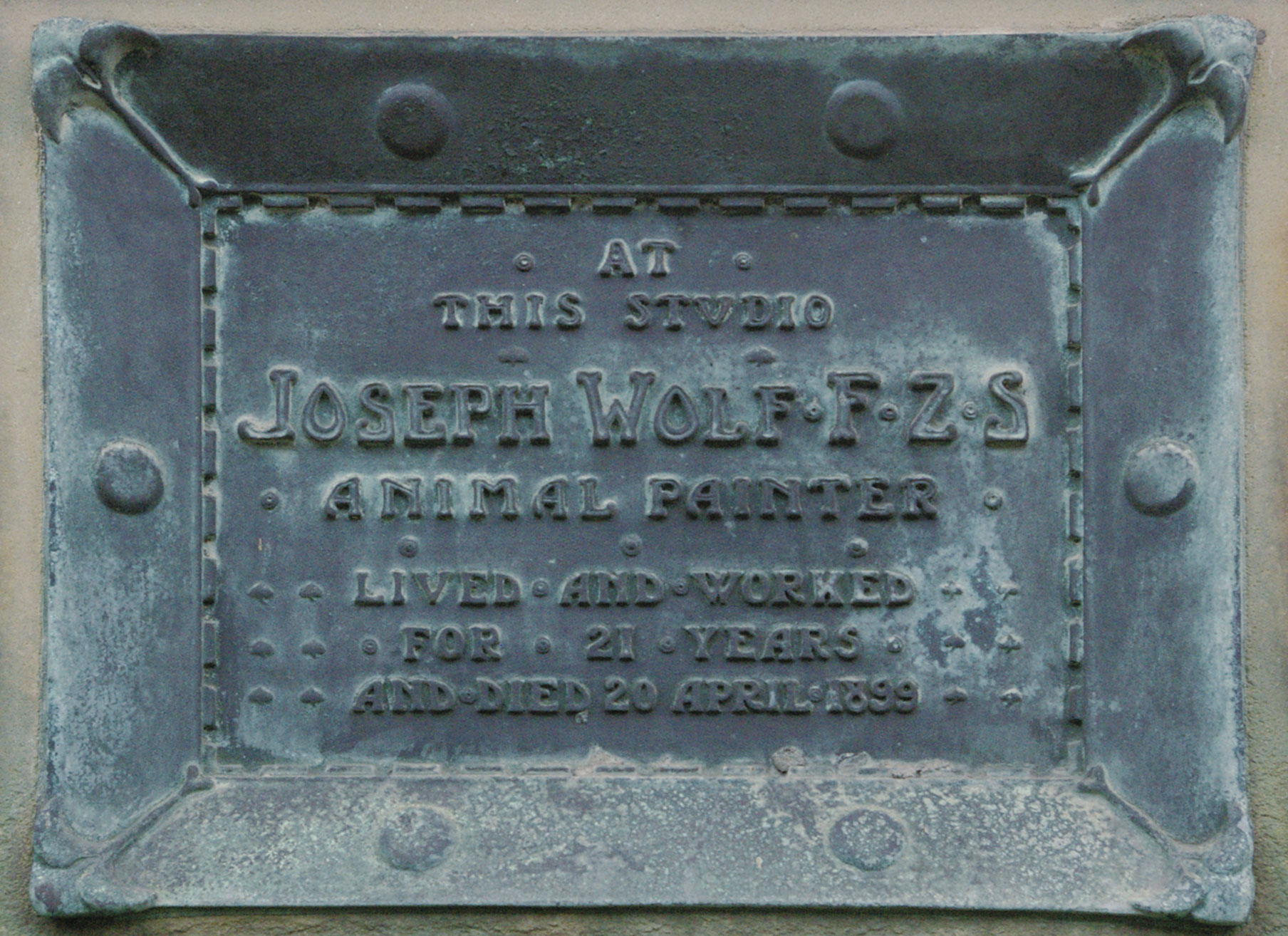
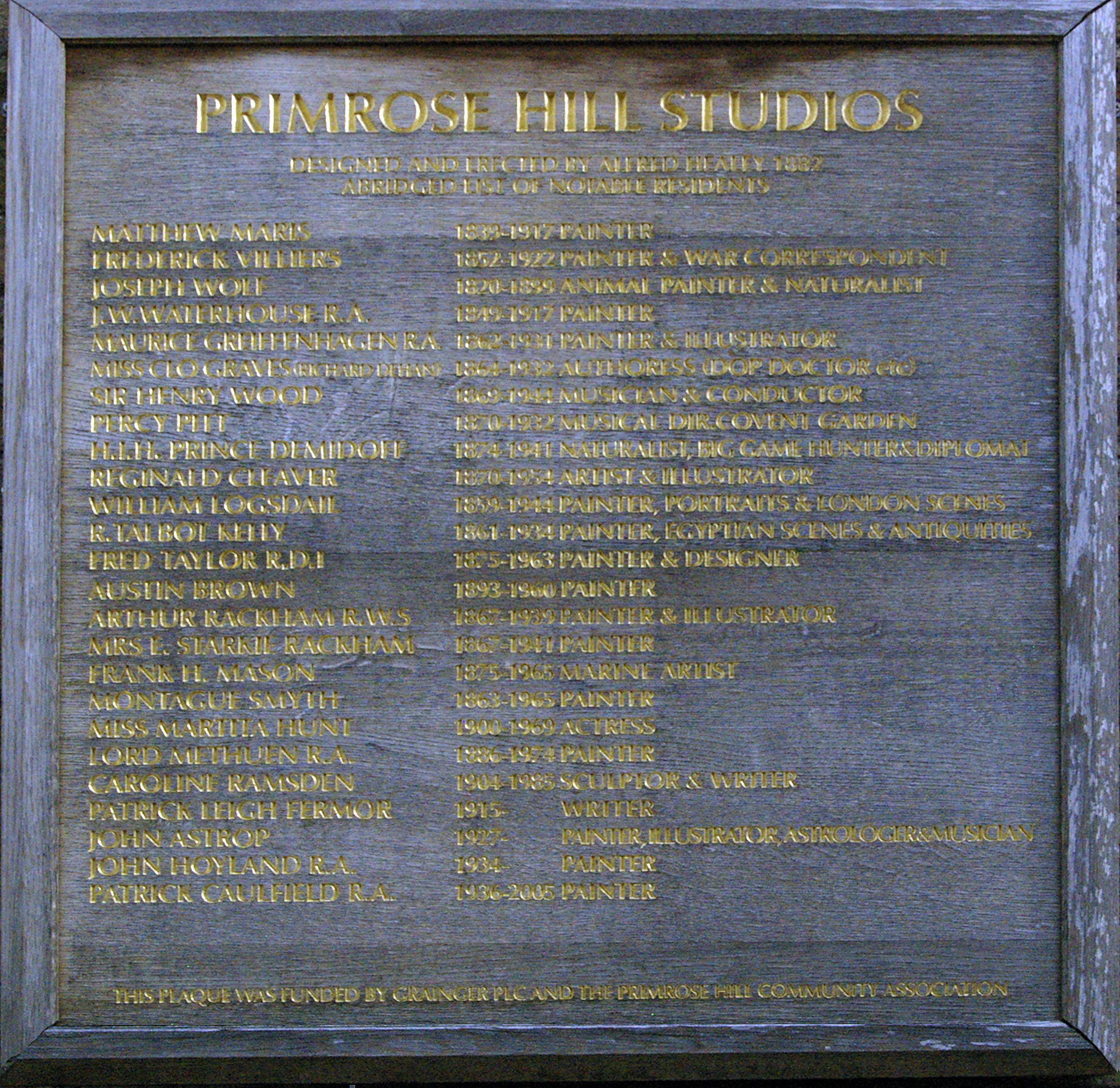
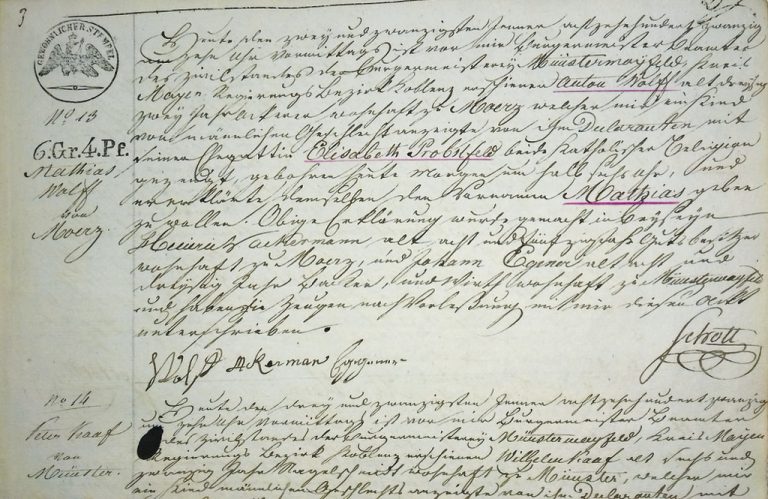
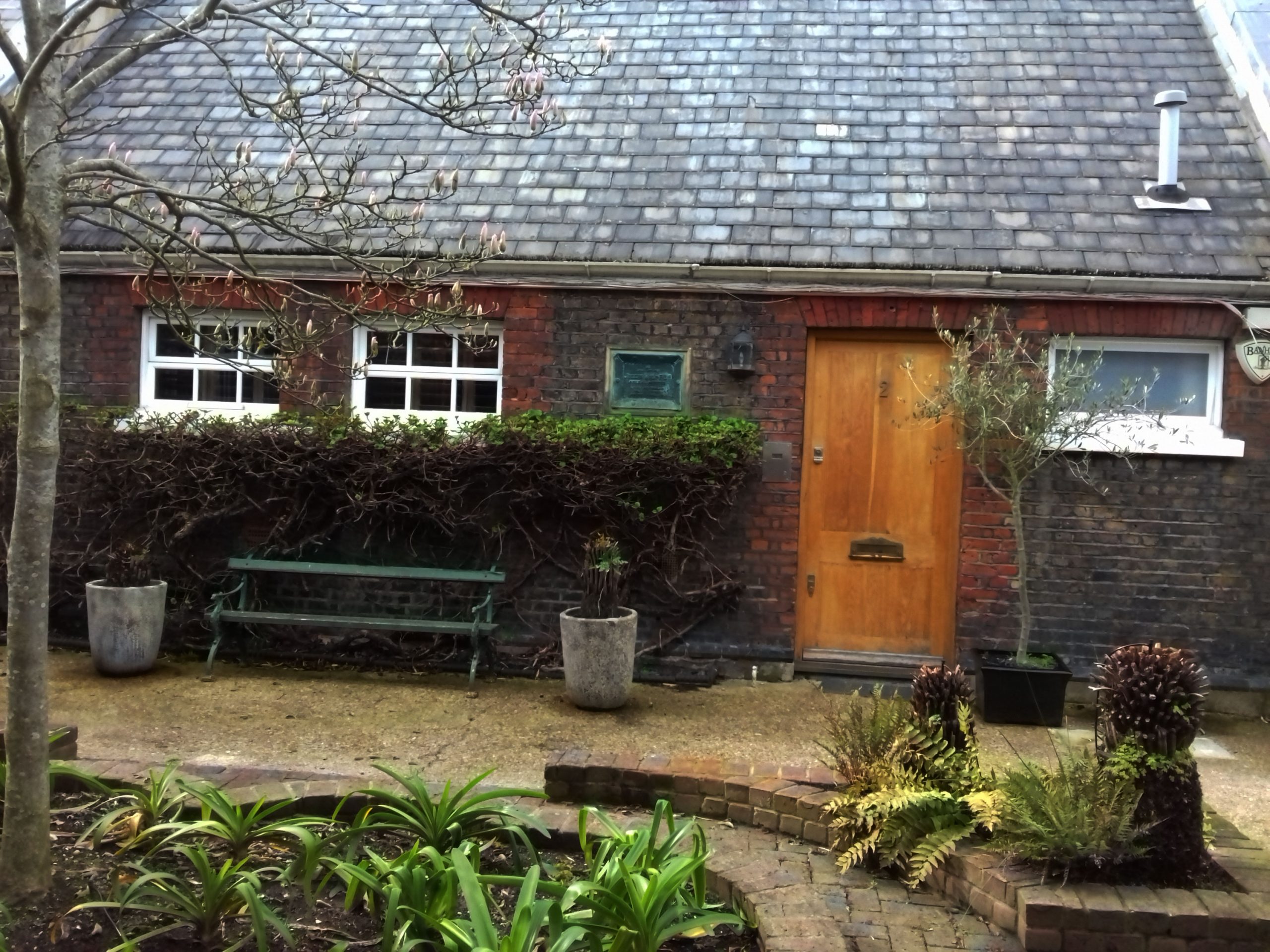
PRIMROSE HILL STUDIOS
DESIGNED AND ERECTED BY ALFRED HEALY 1882
ABRIDGED LIST OF NOTABLE RESIDENTS
MATTHEW MARIS 1839-1917 PAINTER
FREDERICK VILLIERS 1852-1922 PAINTER & WAR CORRESPONDENT
JOSEPH WOLF 1820-1899 ANIMAL PAINTER AND NATURALIST
J.W. WATERHOUSE R.A. 1849-1917 PAINTER
MAURICE GREIFFENHAGEN R.A. 1862-1931 PAINTER & ILLUSTRATOR
MISS CLO GRAVES (RICHARD DEHAN) 1864-1932 AUTHORESS (DOP DOCTOR etc.)
SIR HENRY WOOD 1869-1944 MUSICIAN & CONDUCTOR
PERCY PITT 1870-1932 MUSICAL DIR. COVENT GARDEN
H.I.H. PRINCE DEMIDOFF 1874-1941 NATURALIST, BIG GAME HUNTER & DIPLOMAT
REGINALD CLEAVER 1870-1954 ARTIST & ILLUSTRATOR
WILLIAM LOGSDAIL 1859-1944 PAINTER, PORTRAITS & LONDON SCENES
R. TALBOT KELLY 1861-1934 PAINTER, EGYPTIAN SCENES & ANTIQUITIES
FRED TAYLOR R.D.I 1875-1963 PAINTER & DESIGNER
AUSTIN BROWN 1893-1960 PAINTER
ARTHUR RACKAM R.W.S. 1867-1939 PAINTER & ILLUSTRATOR
MRS. E. STARKIE RACKHAM 1867-1941 PAINTER
FRANK H. MASON 1875-1965 MARINE ARTIST
MANTAGUE SMYTH 1863-1965 PAINTER
MISS MARTHA HUNT 1900-1969 ACTRESS
LORD METHUEN R.A. 1886-1974 PAINTER
CAROLINE RAMSDEN 1904-1985 SCULPTOR & WRITER
PATRICK LEIGH FERMOR 1915- WRITER
JOHN ASTROP 1927- PAINTER, ILLUSTRATOR, ASTROLOGER & MUSICIAN
JOHN HOYLAND R.A. 1934- PAINTER
PATRICK CAULFIELD R.A. 1936-2005 PAINTER
THIS PLAQUE WAS FUNDED BY GRAINGER PLC AND THE PRIMROSE HILL COMMUNITY ASSOCIATION
|
Wolf Ackerman Eggener (Unterschriften/Signatures) Schott |
|
|
Heute, den zweiundzwanzigsten Januar achtzehnhundertzwanzig um zehn Uhr vormittags ist vor mir Bürgermeister Bekannter des Zivilstandes der Bürgermeisterei Münstermayfeld Kreis Mayen Regierungs-bezirk Koblenz erschienen Anton Wolff alt dreißig zwei Jahr, Ackerer wohnhaft zu Moerz welcher mir ein Kind von männlichen Geschlecht anzeigte von ihm Declaranten mit seiner Ehegattin Elisabeth Probstfeld beide katholischer Religion gezeugt geboren heute morgen um halb sechs Uhr und er erklärte, demselben den Namen Mathias geben zu wollen. Obige Erklärung wurde gemacht im Beisein Heinrich Ackermann alt acht und fünfzig Jahr Gutsbesitzer wohnhaft zu Moerz und Johann Egener alt acht und dreißig Jahr, Bäcker und Wirth wohnhaft zu Münstermayfeld und haben die Zeugen nach Vorlesung mit mir diesen Akt unterschrieben. |
Today, the twenty-second of January eighteen hundred and twenty at ten o’clock in the morning, the mayor of Münstermayfeld, the mayor of the Mayen district of Koblenz, Anton Wolff, thirty two years old, appeared before me, Ackerer resident in Moerz who showed me a child of male gender, Declarant and his wife Elisabeth Probstfeld both Catholic religion, born this morning at half past five and he declared to want to give him the name Mathias. The above declaration was made in the presence of Heinrich Ackermann aged eight and fifty years, estate owner resident in Moerz and Johann Egener aged eight and thirty years, baker and innkeeper resident in Münstermayfeld and the witnesses signed this document with me after reading. |





Quellen / Sources:
Wikipedia
Mark Todd (Ururenkel des Joseph Wolf)
Webseite der Familie Willingale (https://www.willingale.me)
*Wolfgang Fuhrmann